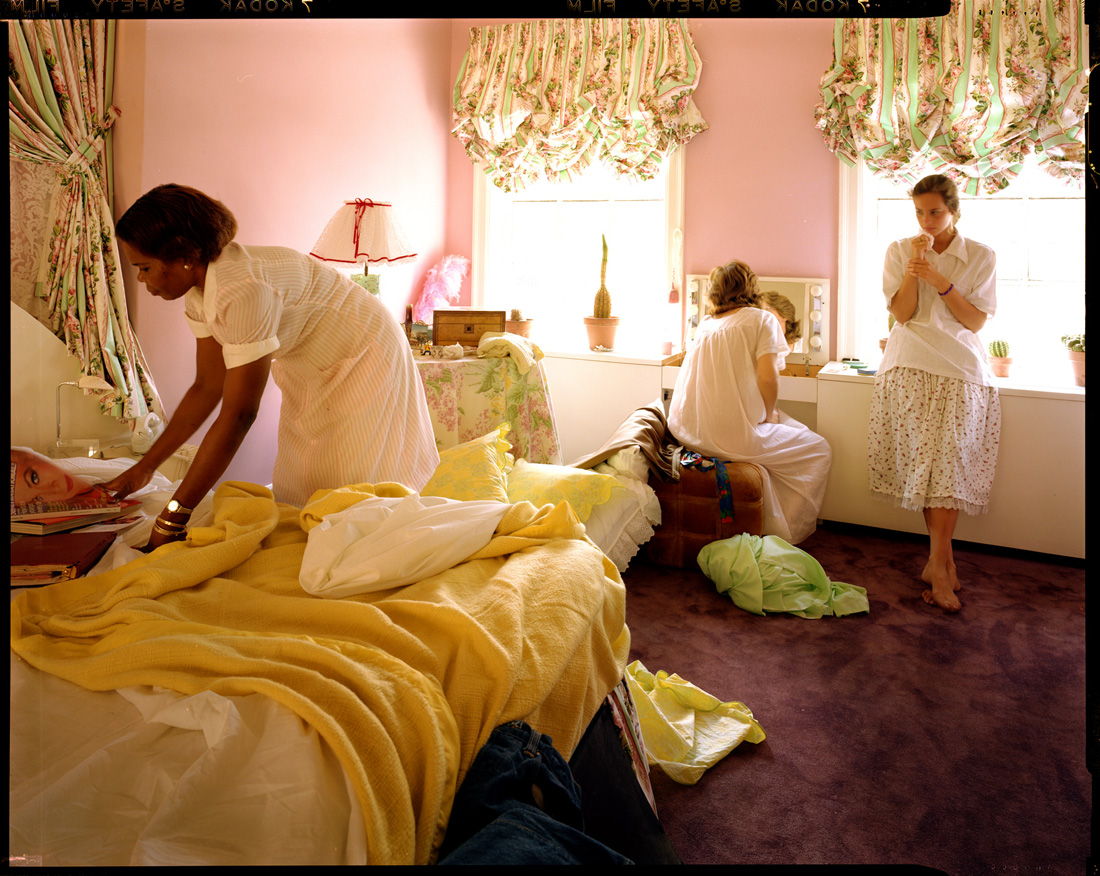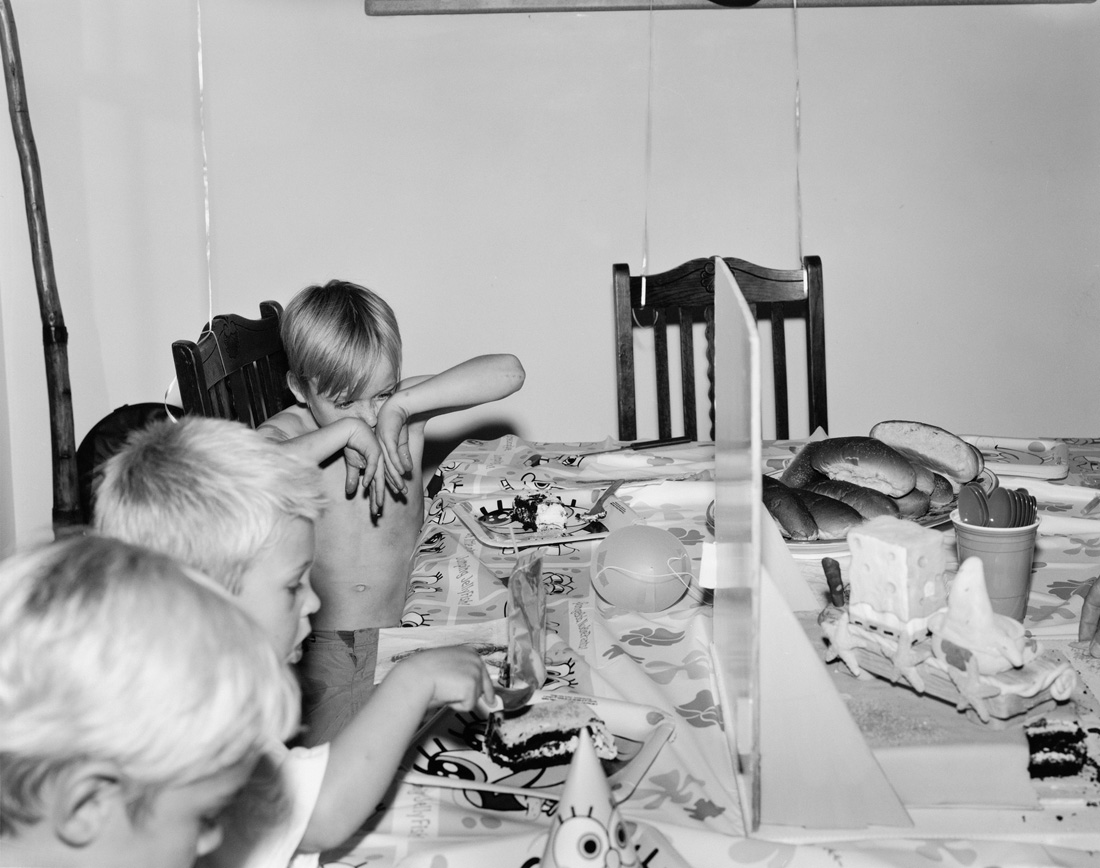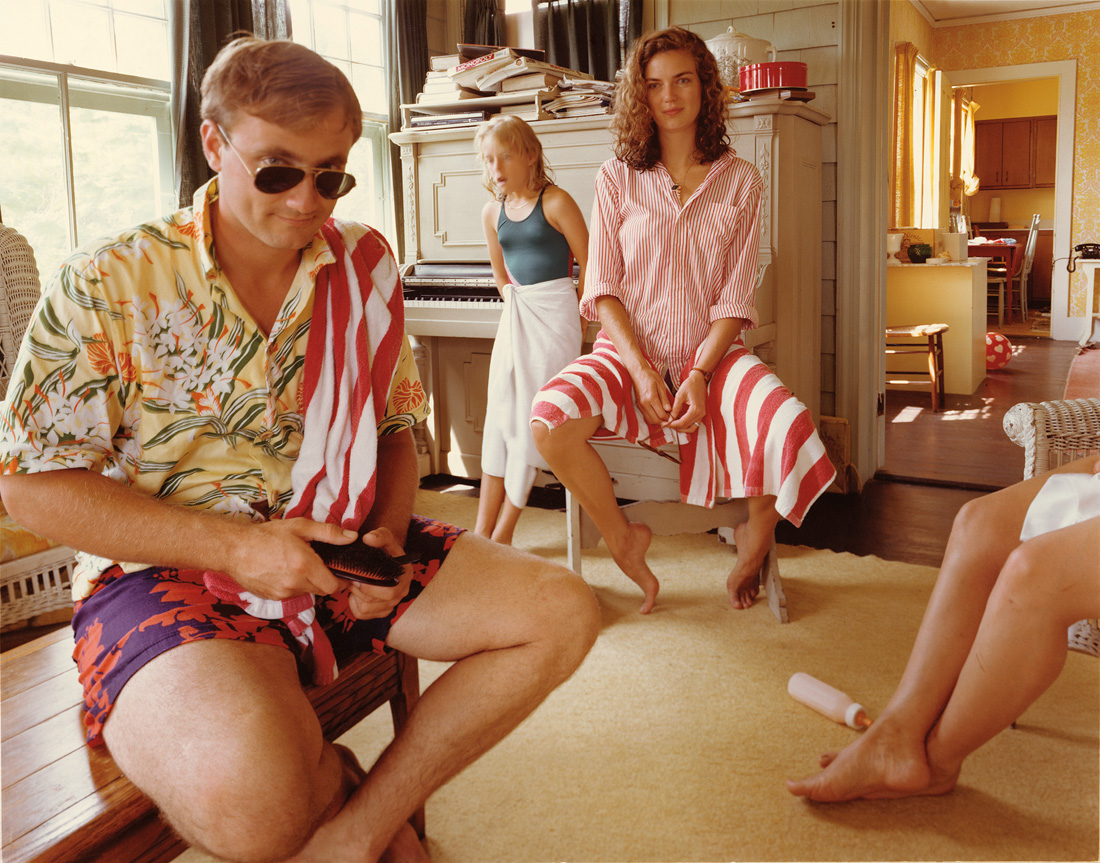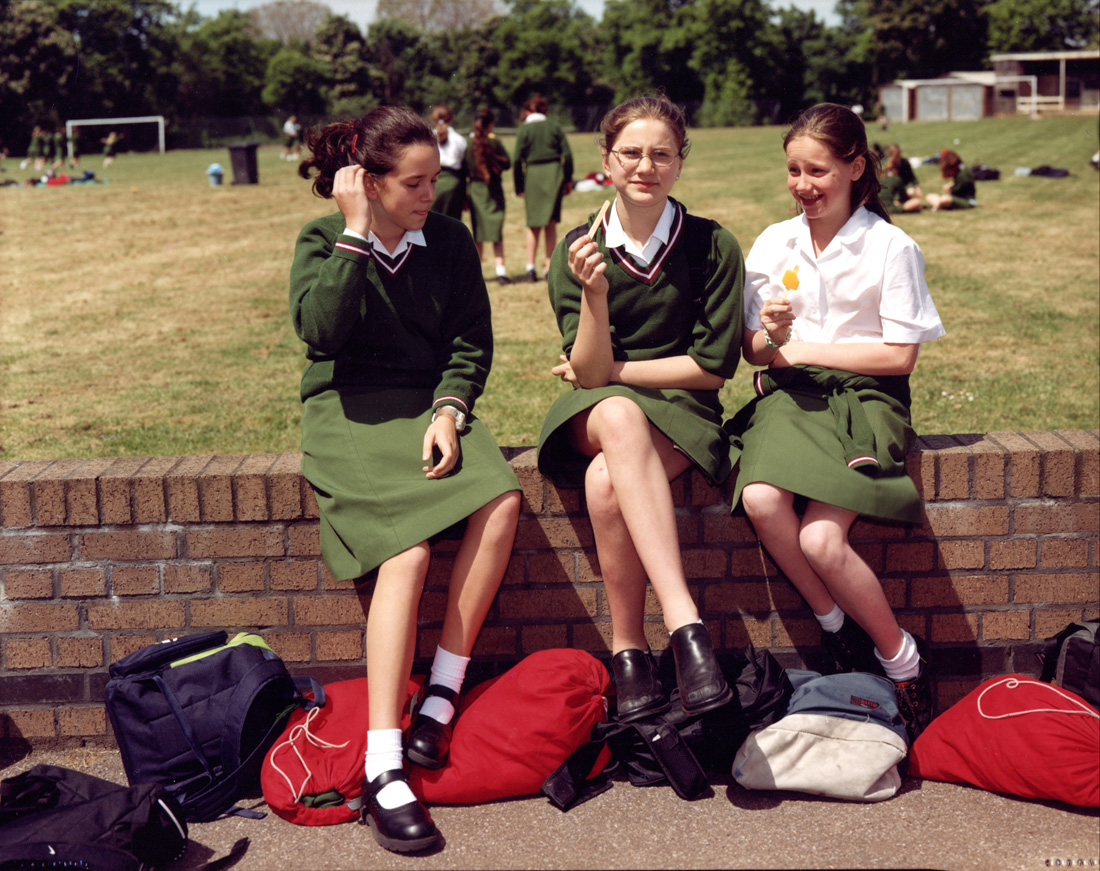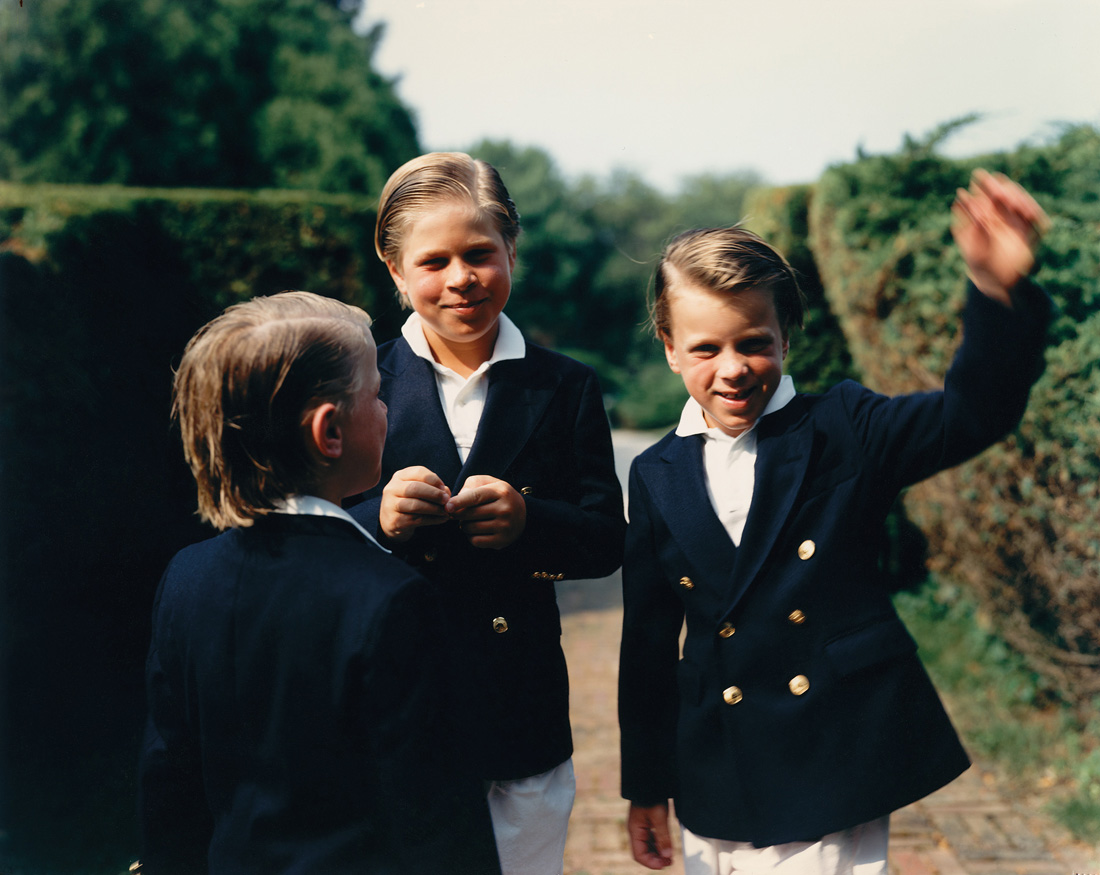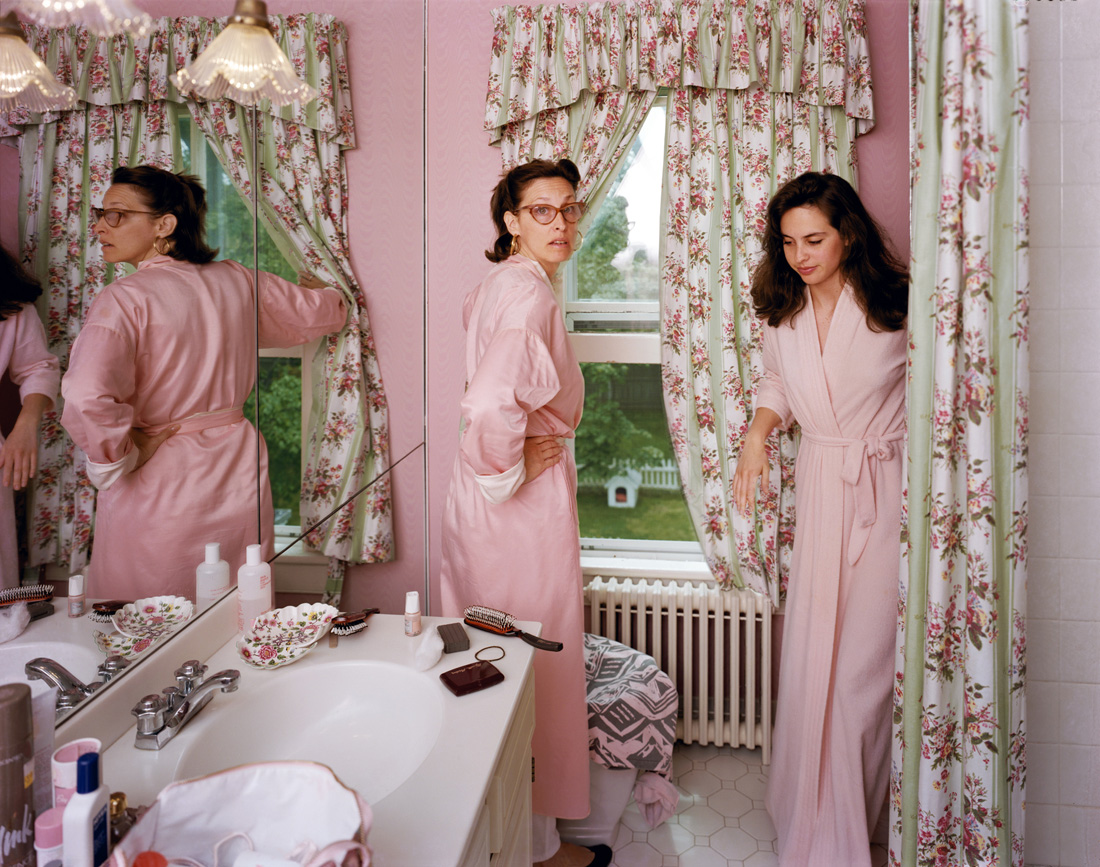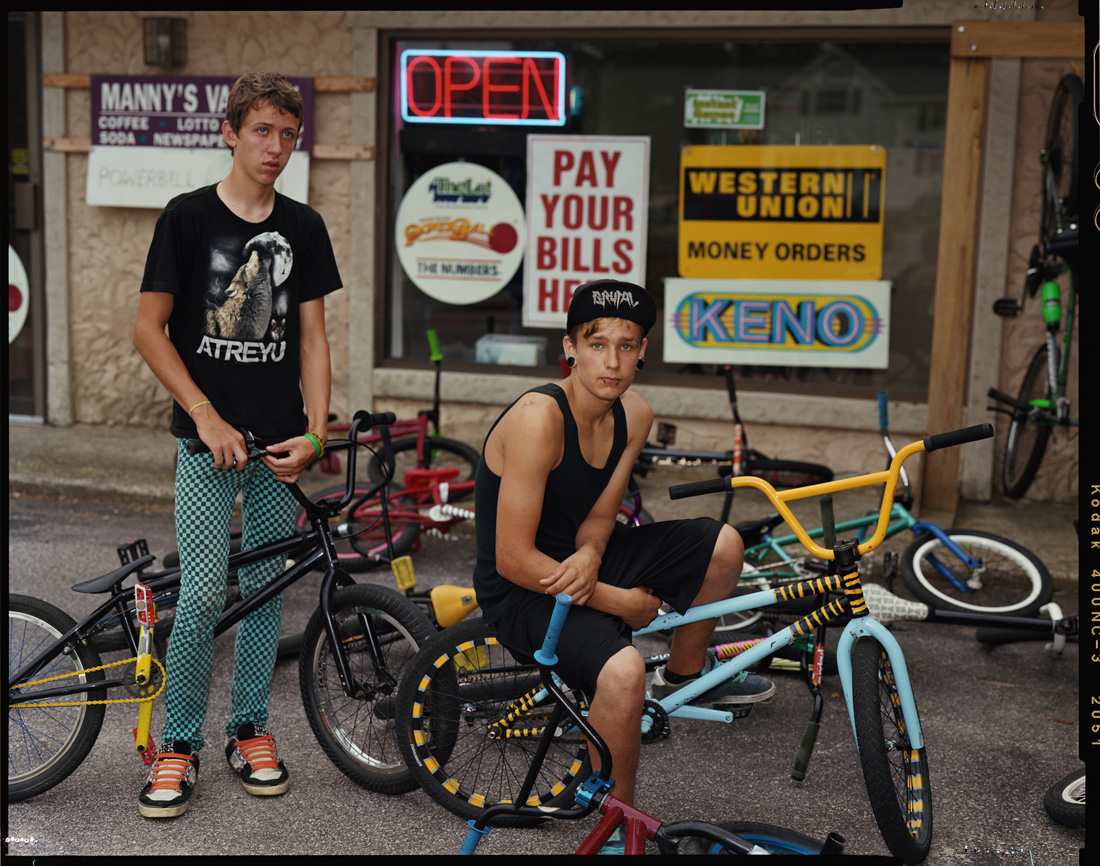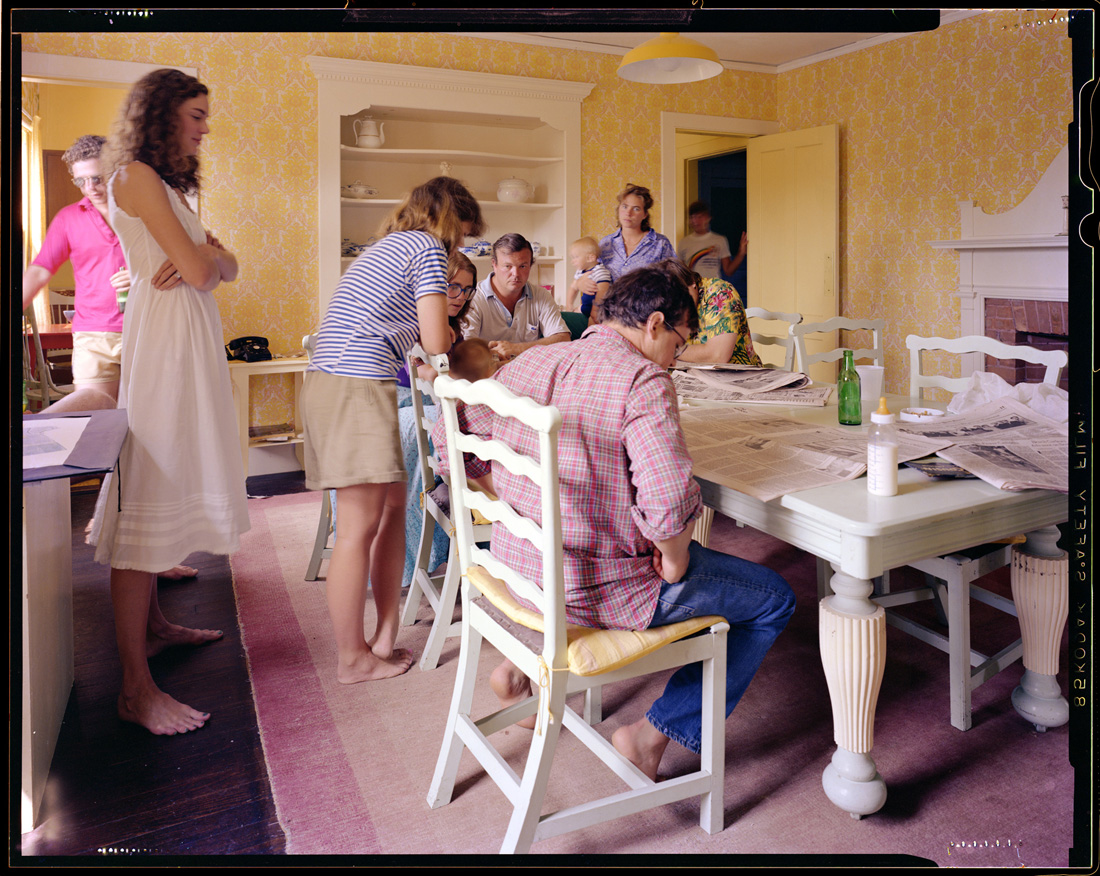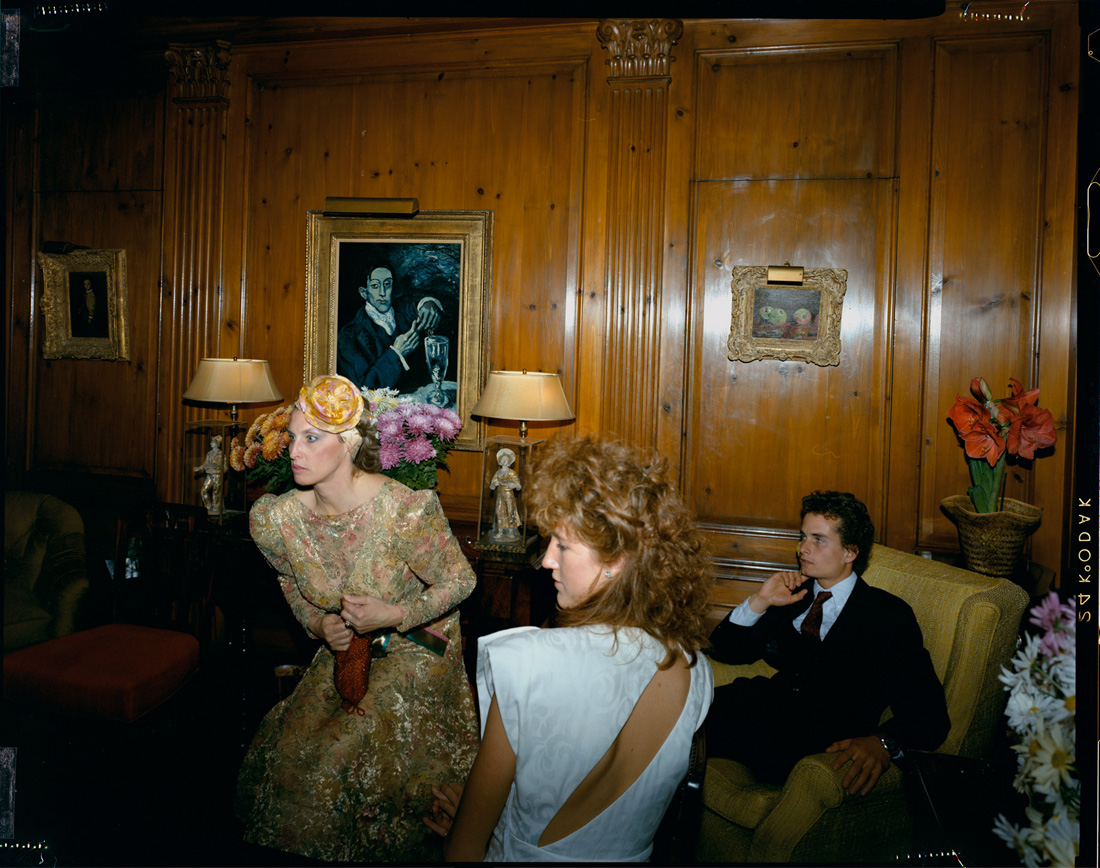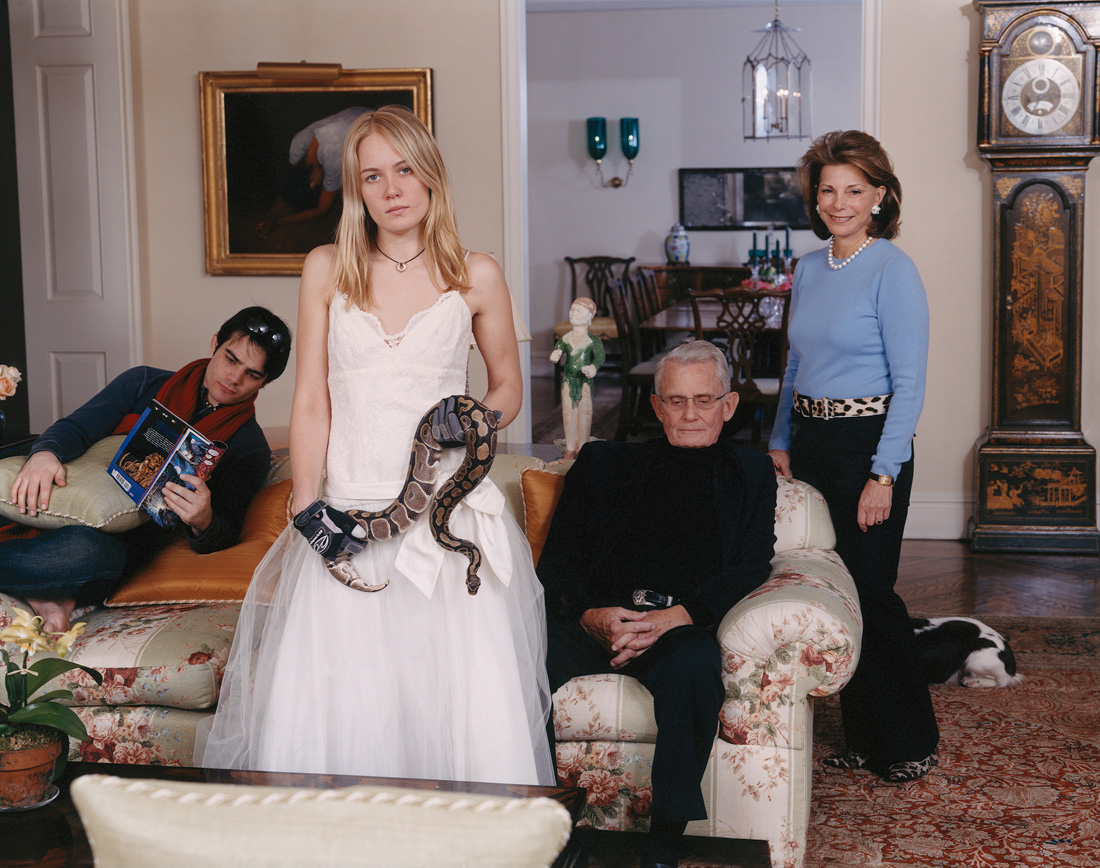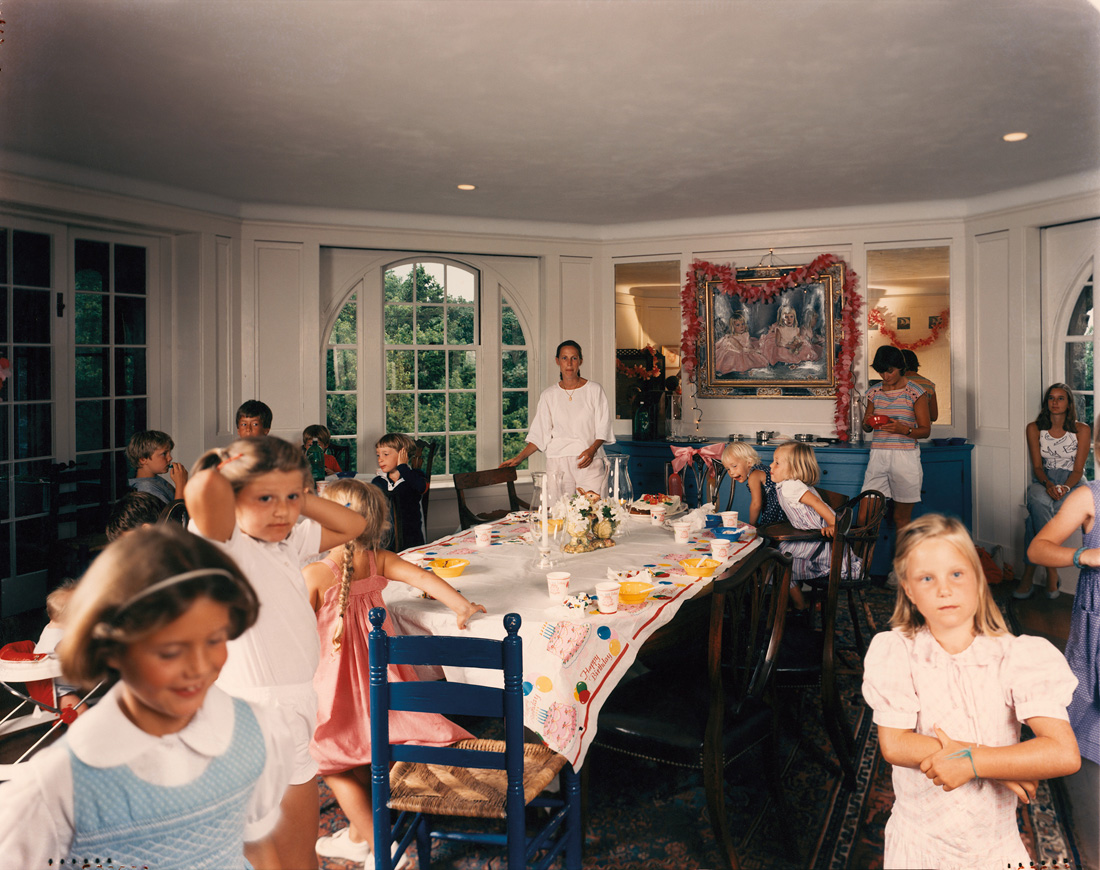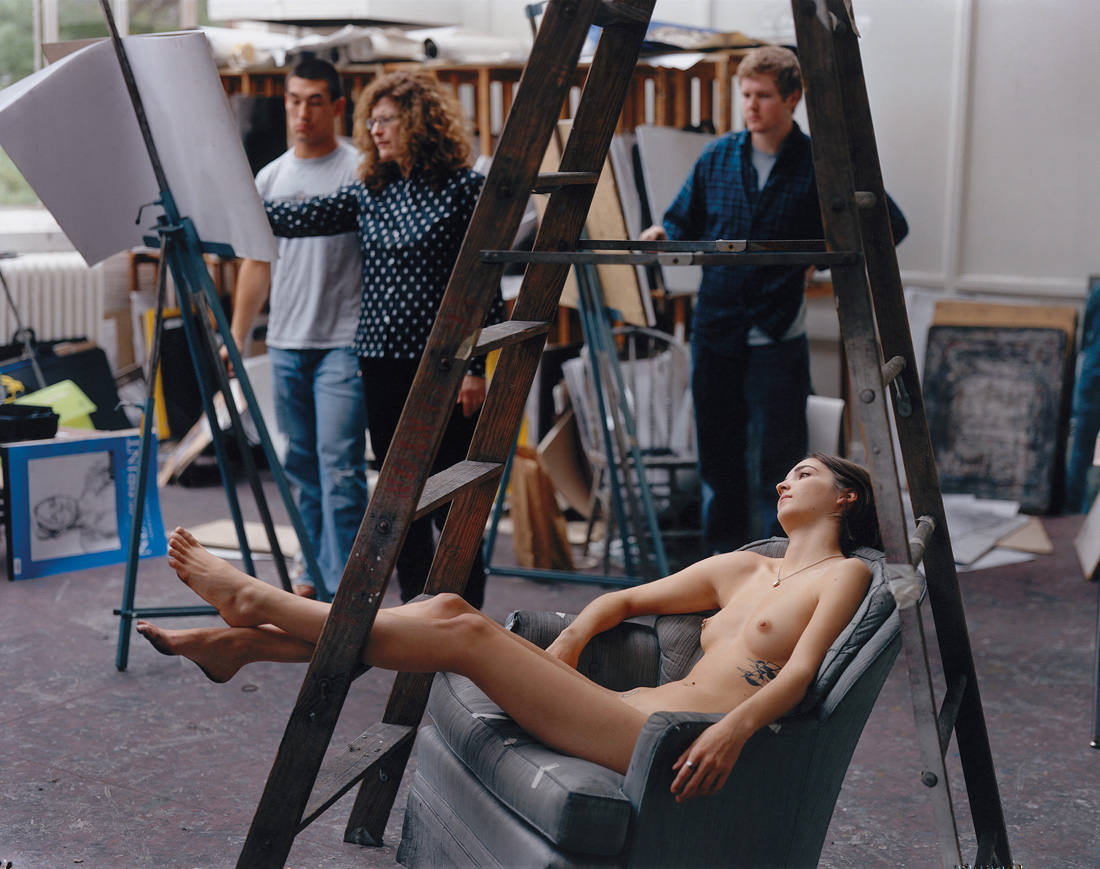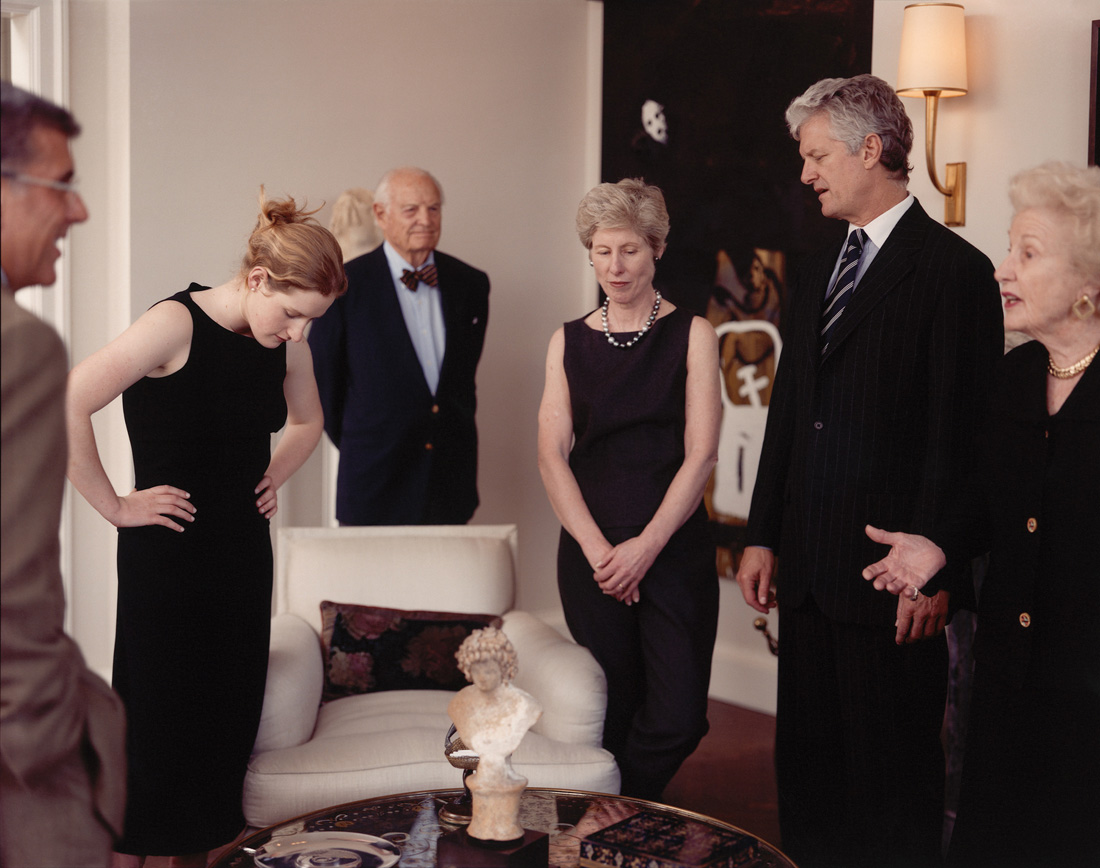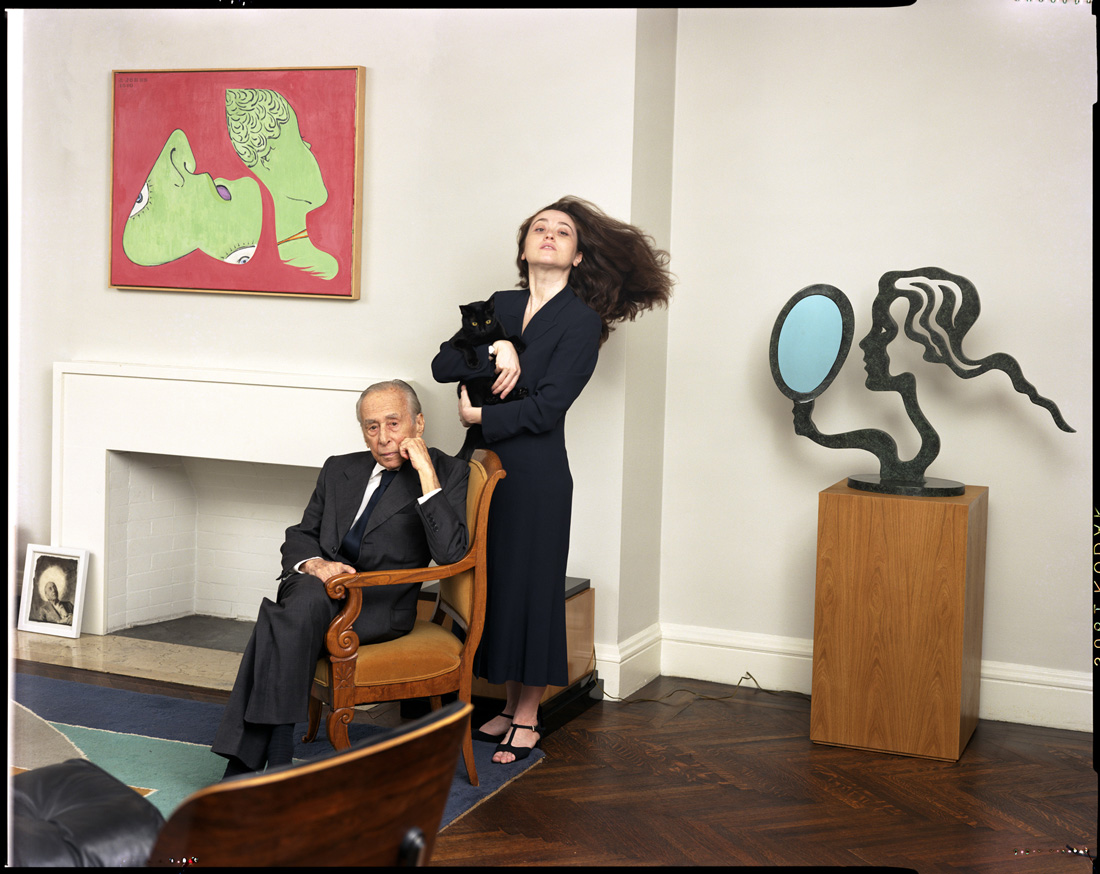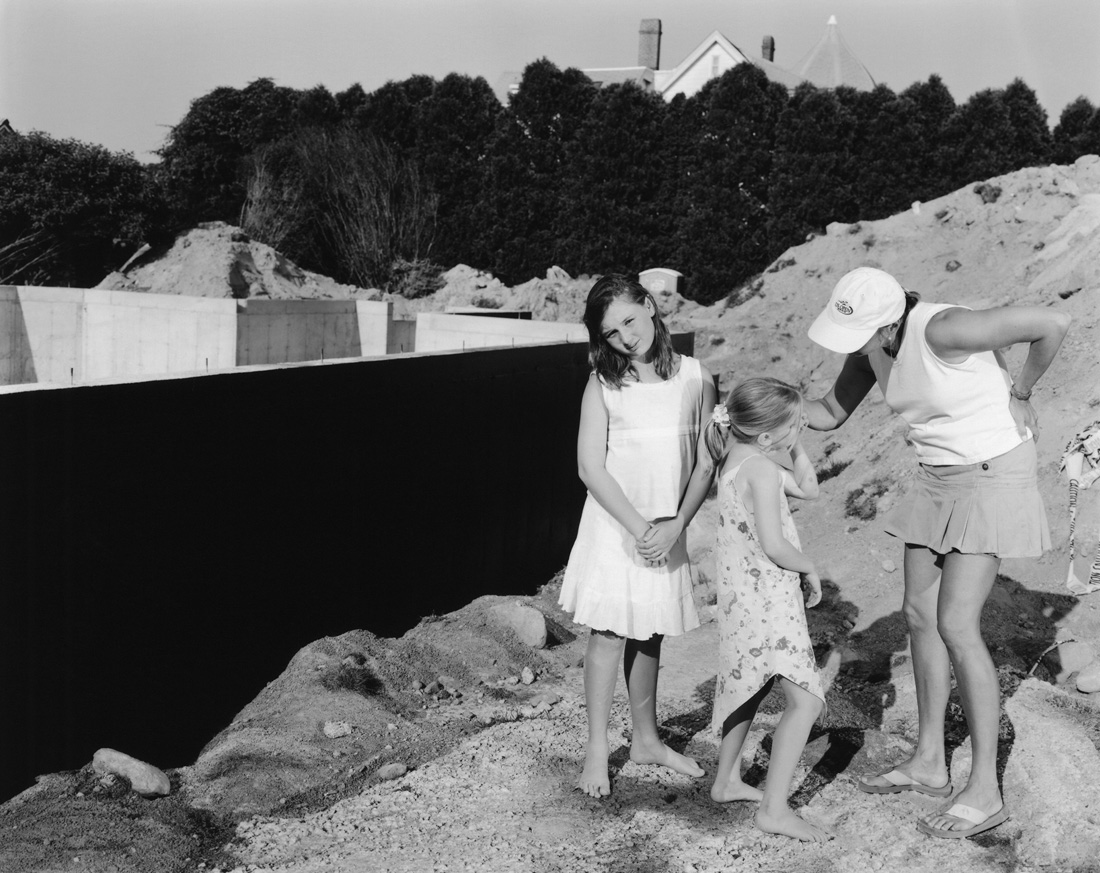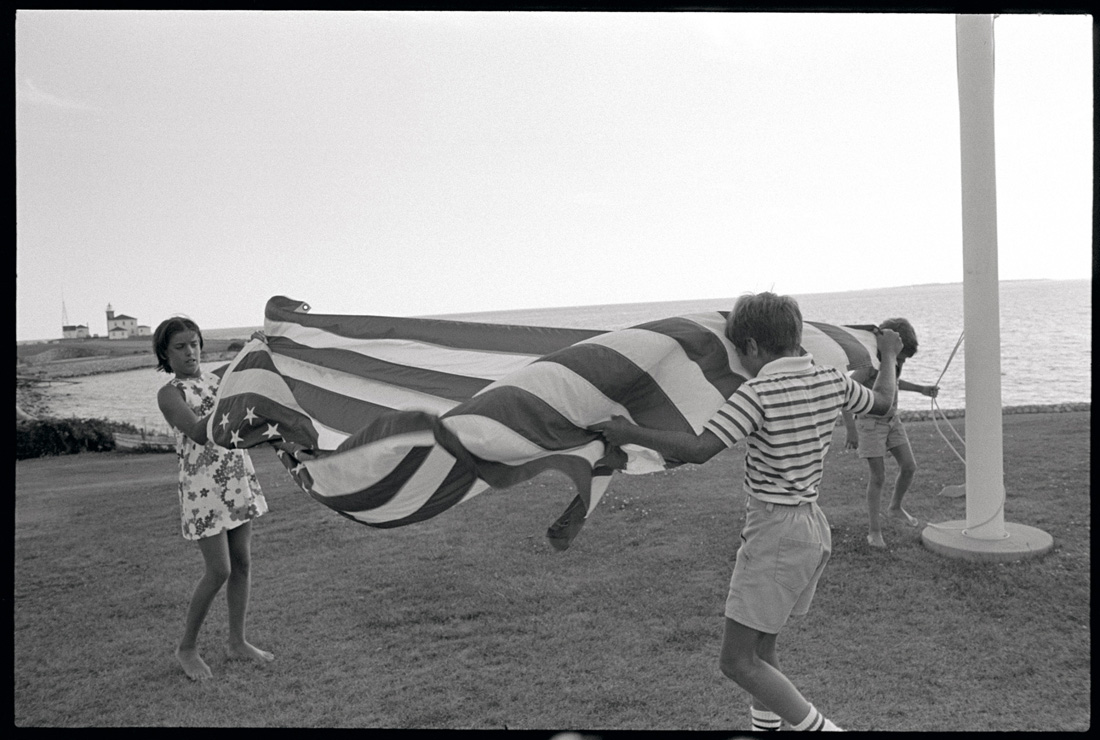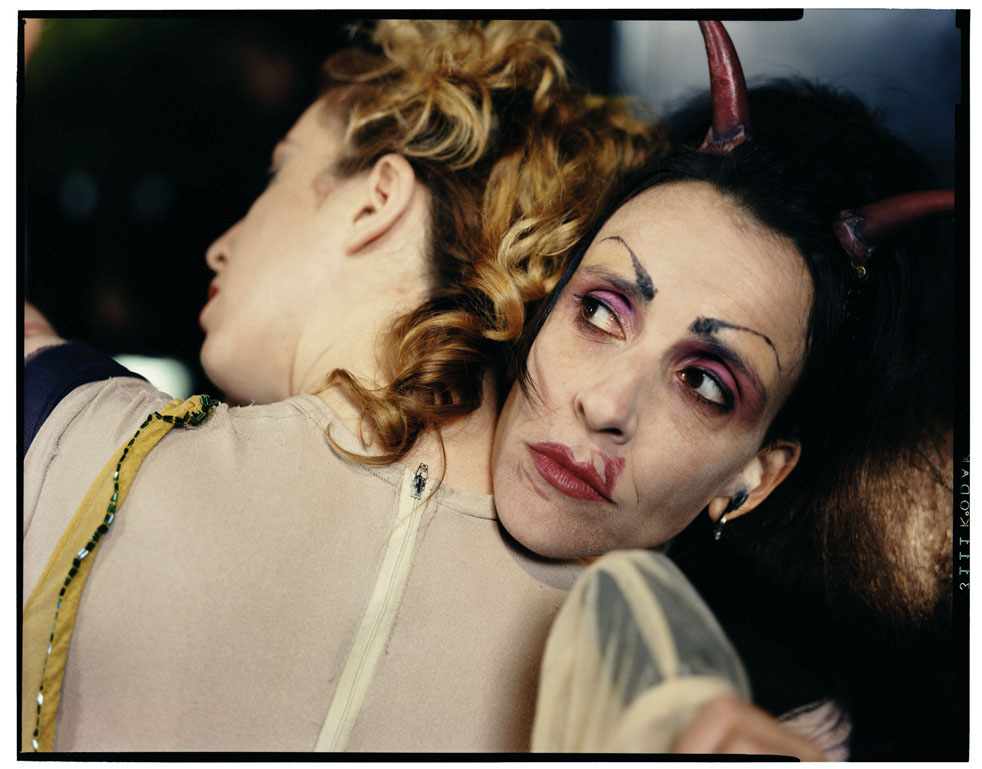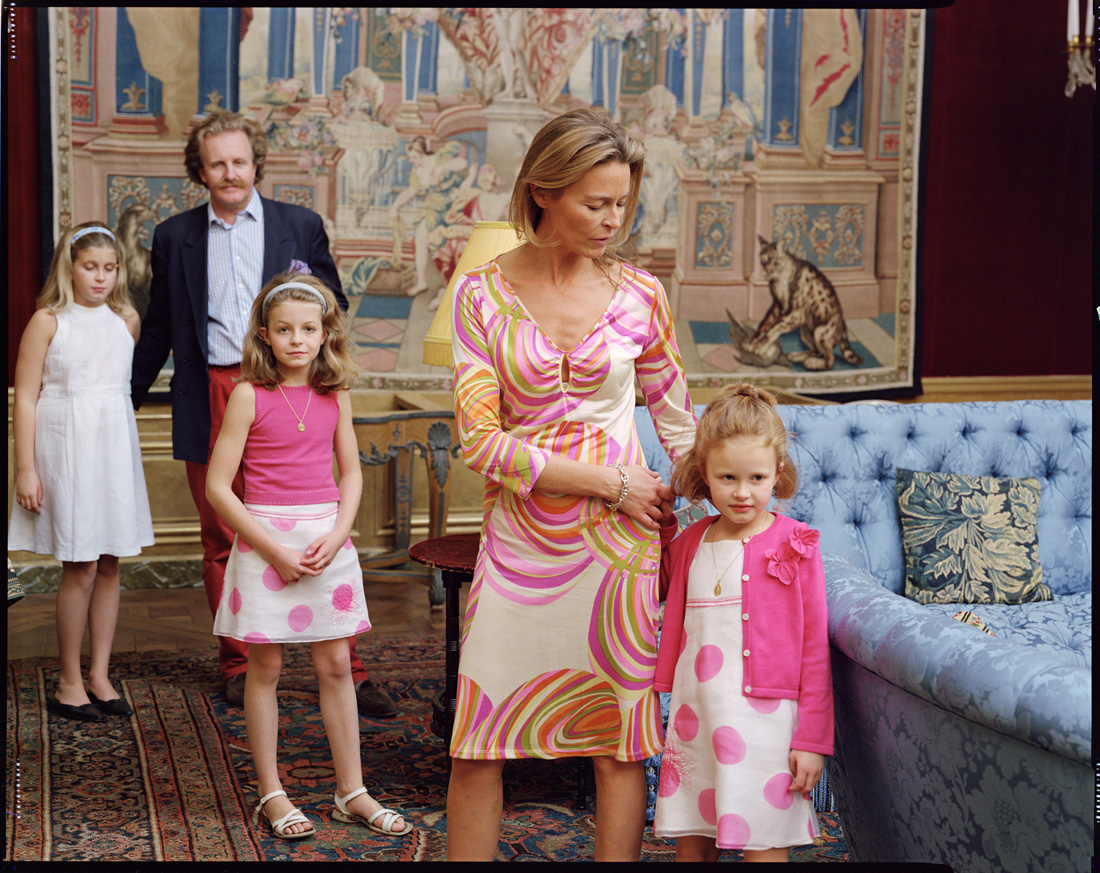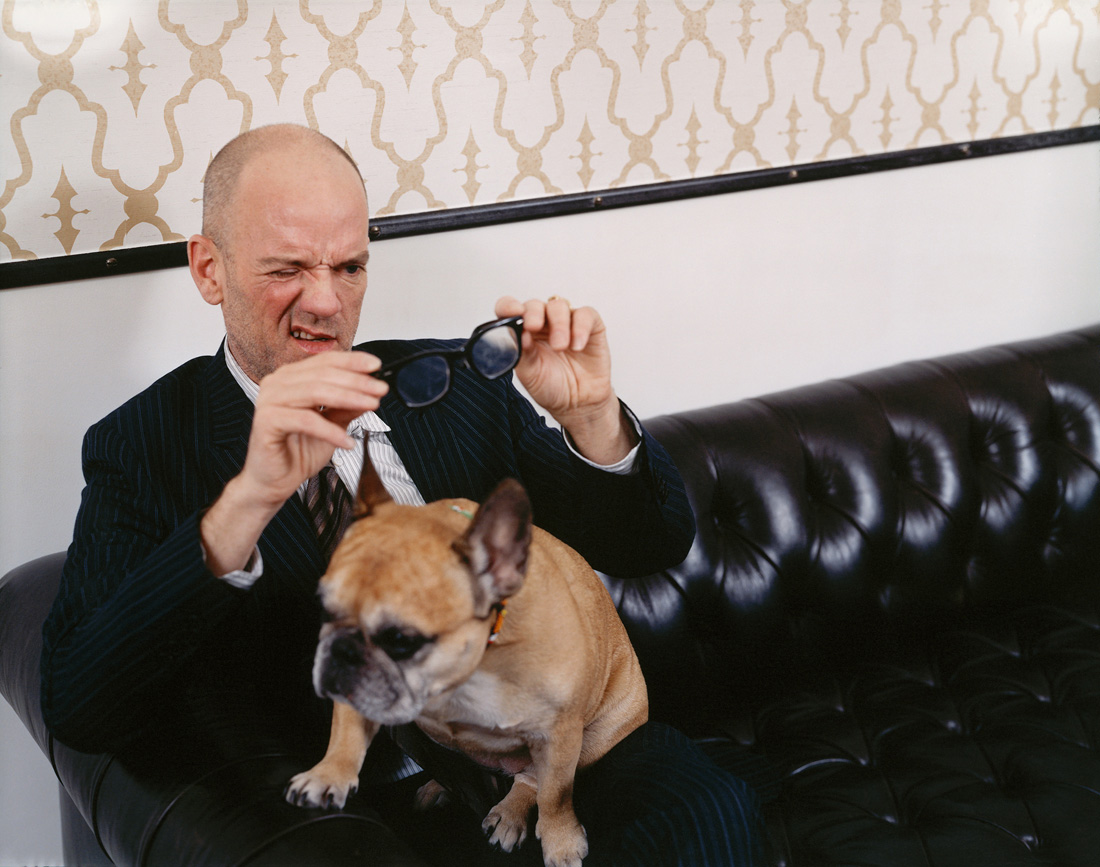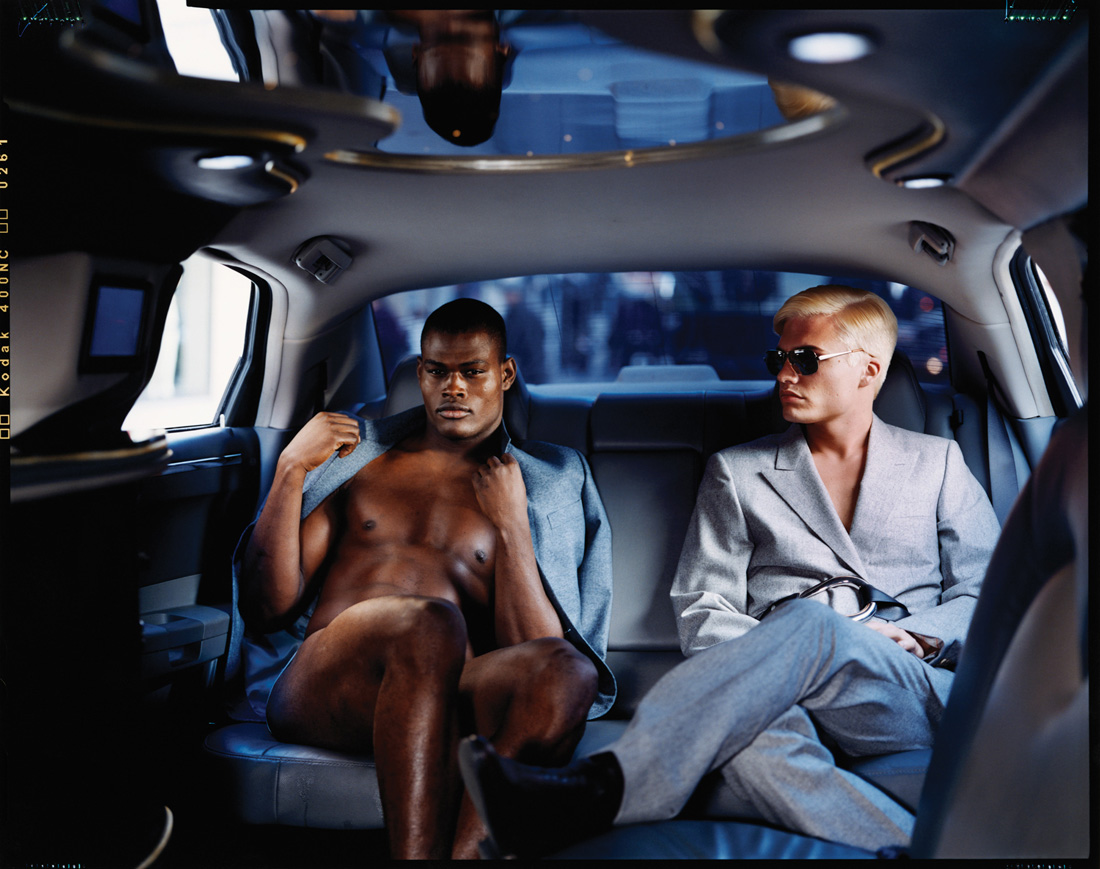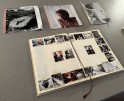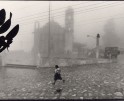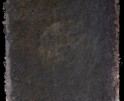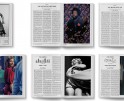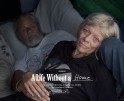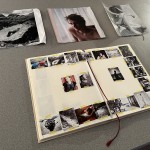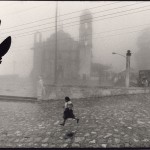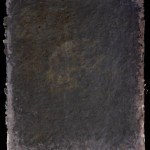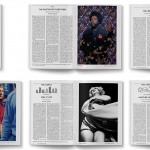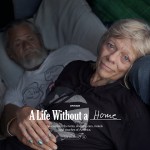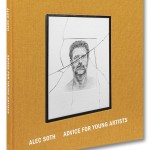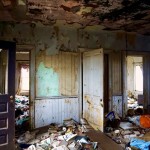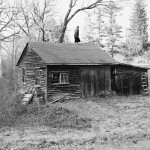Ken Weingart interviews Tina Barney – Ken Weingart Photography Art Reviews-Interviews
Today, I am sharing an interview that photographer and blogger, Ken Weingart conducted with photographer Tina Barney. Ken has been producing interviews for his Art and Photography blog, and he has kindly offered to share a his interviews with the Lenscratch audience.
Tina Barney is one of the most acclaimed fine art photographers in the U.S. She became well known photographing her real family in Rhode Island, and making large color prints from these interactions. While still in the midst of a thriving career, she recently had an exhibition of her current and past works called Four Decades, at the Paul Kasmin Gallery in New York. All images © Tina Barney, courtesy of Paul Kasmin Gallery
When did you first think about becoming an artist?
I got married when I was twenty and I had my first child when I was twenty-one. I had my second child at twenty-three. At that point, I had started collecting contemporary art and was a photography collector. That was in the early 70’s, which at that time we decided to leave New York City and moved to a ski resort called Sun Valley, Idaho. It was a very sophisticated school. A lot of photographers whose photographs I collected came there to teach; it was like jumping into an MFA program right from the start. That’s where I learned all my photography.
You studied in Italy as a young lady. What took you there and what did you find?
I lived there when I was nineteen years old, and later I went back to do some of the images for The Europeans. I went on my own. I have always been interested in languages, and I was thinking of studying the Italian Renaissance, and a friend of mine who wanted to be an opera singer was already living there.
How long were you there, and in what city?
A year. We were in Florence, but we lived with an Italian family. This was a very typical thing to do. But, I also lived in Lausanne, Switzerland when I was fourteen. I went to a boarding school because I wanted to learn how to speak French. I went to Europe a lot as a child — so, it wasn’t that unusual.
You are still fluent in French and Italian?
It depends what you call fluent.
Can you hold a conversation?
I probably couldn’t do a lecture, but I can understand it.
How did you like Italy and what was the impact on you?
I loved it. The impact was basically the exposure of art, but I also almost married an Italian.
You studied for fun, school, or knowledge?
I was pretty serious. I wouldn’t say that I would have done that for fun. It wasn’t for fun. I was very serious about what I did.
Was it a career move? Was it about art?
No. There was never a thought of being an artist.
You were at the Sun Valley Centre for the Arts about 1975?
I lived there for ten years and that’s what I did for those years besides bringing up my children. I didn’t start by making photographs, but more learning how to print them, and learning the history. I had spectacular teachers. I started photographing back in Rhode Island, where I lived from the time I got married at twenty till today. I started photographing at Sun Valley and then in the East Coast because I began to realize it was such a two shift between the East Coast and the West Coast.
And you studied with Frederick Summer, Roger Mertin, Joyce Niemanas, Nathan Lyons, Robert Cummings, and John Pfahl?
Yes, all the people that you have listed, I studied with in Sun Valley.
And they were private workshops?
They were private workshops. There was an Art School called, the Sun Valley Centre for Arts and Humanity, and that’s where they were. It was a small school started by the wife of the person who owns Sun Valley. She was interested in art, so she started the school. It still exists, but it doesn’t have workshops, unfortunately, anymore.
So the impact was big?
Huge. You also have to realize that I had already started to be very interested in photography before I got there. Before I got to Sun Valley, I started collecting. I never made any pictures until I got to Sun Valley. In those ten years I learned a great deal, not only about photography, but also about art and perceptions, about many different things.
At that time, photography wasn’t as respected as an art form?
It wasn’t, but I was on the West Coast, which is very different from the East Coast. On the West Coast, people were so enamored with athleticism and that school of photography. So there was a huge following from the West Coast and it was the very beginning of everything in the history of fine art photography. I think that the average person wasn’t aware of fine art photography as such, even our lecturers weren’t aware of fine art photography in the 70’s.
What were you collecting back then?
First of all, keep in mind that photographs cost about a hundred dollars at that time, at most. I began volunteering at the Museum of Modern Art. I started visiting two galleries that existed in New York City at that time, and began learning from the people who worked in those galleries.
Would you say you are one of the first fine art photographers to make color prints? It was still a new medium at that time.
No, the show that changed my life was a show called, Big Pictures By Contemporary Photographers. I don’t know whether you know about that show, but it was the most important show for large color. At that time, I don’t think Cindy Sherman was in it as she was too young. It was 1983 and it was under John Szarkowski. I did not realize other people were making big pictures. Cindy Sherman was making big pictures because she actually was one of the people that influenced me to make big pictures, so that show was the first show that really pointed to the people who were making big pictures. There was one lab in Berkeley, California where all West Coast photographers were going. No, there were quite a lot of other people doing large color prints. There was Larry Sultan, Nan Goldin, and Philip-Lorca diCorcia. They were a lot of people doing that, so it wasn’t just me.
Was the idea to go large like painters do?
I didn’t even think about that. I wanted the viewer to be able to see every little detail in the picture, and feel as if they were in that room — like looking at a movie.
And you made some of them yourself?
Oh God, no. You can’t make those yourself. You have to have this gigantic enormous machine. So, no, it was a lab that made it.
Would you say William Eggelston was the pre-eminent groundbreaker of color?
He was definitely very important as far as color was concerned. He and Steven Shore were almost in a different group. They never made big pictures. Steven never made big picture until recently. They really knew what they were doing.
You are friends with Cindy Sherman?
I wish. I met her once, but never had a conversation, which I would have loved.
Who are some of the photographers past and present you most admire?
Cindy Sherman, definitely. She is like the queen to me. The photographers that I really looked up to were usually the German photographers. Definitely Steven Shore is very important; also Gursky, and now Thomas Demand, who is now on top of everybody else, and who is just unique in his own planet.
Was photographing the family as fine art, unique at the time?
I didn’t know there were people doing it. There were very few. The whole thing about directing was unique. The first person, I realized, was directing pictures of family at the same time with me, was a woman called Mary Fry. And then when you go back and look, and you see people like Larry Sultan’s work, it is so close to mine.
You were shooting 8 x10 or 4 x5?
I have used 4 x5 most at the time since 1982. I’ve made about 20,000 4 x 5s. I had to count them recently. Of the 8 by 10’s, I probably made 3,000.
What is the difference in cumbersomeness between the two?
Huge, as I use a great deal of light and equipment to light my photographs.
Did you get to the point where you found the extra value of using the 8 x 10 was not worth it?
The most important thing of all is what you are seeing through the ground glass, and there’s more information and detail with the 8 x 10. I think there’s more of a formal look to them. But I’m doing less large format in comparison to last year. Yet, believe me, I can use a 4 x 5 like a point and shoot. That’s one of the things that people cannot believe. The reason I was able to get what I got is because I use that camera almost like I have a motor drive on it. A lot of the time, I won’t even focus as I go under it. I can focus so quickly .
You are not using an assistant to do the focusing?
The focusing, no. I have assistants for lighting. The reason I need an assistant is to hand me the film.
So they pull the film out and put it back in?
They don’t pull it out. The feeding needs to be very fast.
They are feeding it to you, and you are pushing it in?
I push the film in, and they take it out, quickly. They feed it to me very quickly.
How many types of films do you take on a typical shoot, and is it very expensive?
It started way way back in the 80’s. I started using more films than most people could count. Expensive? I wasn’t thinking about that. I never would take more than thirty shots on a shoot. When you are doing a shoot, you need an hour to set up the lights.
Are you are shooting digital now?
Yes, and it has taken me a long time to understand it, not only with the camera but the lighting, and the translation to making the print.
When did you start learning digital?
I started two years ago.
What camera are you using?
I started with a Canon 5D Mark 3 and very quickly found I didn’t like it. Actually, thanks to Steven Shore, he and I did a project together, and I had a fortunate meeting with him for a tenth of a second. He said, get the Nikon D800. It had a lot to do with the full frame and the shape of the image that I really hated it with the Canon.
Canon is full frame though.
Well, it doesn’t have the same ability to do what the Nikon does, which is more close to a 4 x 5. I don’t know why, but it doesn’t.
You are happy with the resolving power?
Yeah, but you know what I am finding? I’m blowing these up to 40 x 50, and I am using the camera on a tripod and I am using studio lighting, and the resolution is so spectacular, I can’t believe it. I never thought it could be possible, and I am really excited.
And they are not disintegrating?
No, it’s fantastic. I am very strict with the exposure, aperture and ISO. I’m really going back to almost using it like a large format camera with a tripod.
Just the Nikon or also the Canon?
I never tried blowing them up with the Canon because I didn’t like what it was doing.
So with digital, you are not seeing a huge difference with film?
Oh no, there is a difference. I verbally say it because it’s technically complicated to describe it. I feel as if the part that I am interested in the most is the word translation. The textures are translated differently. I can’t think of any other word.
Do you still see the resolving power and the superiority of 4 x5?
There’s obviously no grain in a 4 x 5, right? And yet, if you do everything correctly, there is no grain when you go close up to a picture of a digital. But you know what’s the difference is? It’s a different texture. It is as if you took silk and put it next to… I shouldn’t say next to velvet, because then it will sound like one is better than the other. It’s really like you are talking about two different textures. Use that word, texture.
And what is superior?
Neither, they are different. That’s the part that is hard for me, because I was so worried that 4 x 5 would remain superior, and now I realize that it’s just different.
What ISO and aperture?
I’m trying to use it at 160 but sometimes I go to 320, and 640. The f/ stop is at about f 9.
640 is huge compared to what you were shooting on with 4 x 5.
I know. Mostly, believe me, I’m doing it at 160.
What kind of lighting and equipment do you use?
Zano lights that I have been using forever, and that’s another reason I had to go digital. I couldn’t get the instant film for 4 x 5 anymore, and I could not put a digital preview on the back of my 4 x 5. I couldn’t deal with it.
You take a long time generally with each of you series?
I don’t flip around from project to project. If you look at my projects, the first book that I did was thirty years. The second was The Europeans book and it took eight years. The third book, I called Players, and it was also many years. Then I did a project called Small Towns and that was seven years. I don’t flip around. When I choose a subject, I stay with it for years because I just don’t think I’m ever done.
It’s hard for you to say, I’m done?
Yes, you know after seven years— it’s a long time. I finally say I’m done. I can’t find anything more. Sometimes it takes me a long time.
Do you do much magazine work?
I did. Now I do much less editorial because when digital came in, either they thought I don’t do it, or I turned down a lot of jobs. I don’t know which jobs are worth it sometimes. If I don’t think I can get something out of the subject, I turn it down. If someone is in the shot just standing in an office, it’s not going to work for me.
And commercial?
For commercial, I don’t get it very often. I did some really great campaigns for Tory Burch, and a few others, but not many. I would like to do more. I have a commercial agent, but they don’t come that often.
For your printing and framing, how much time and energy goes into that?
With framing, I have nothing to do with that. For the printing, there are two things. First of all, when I take pictures, now especially with the digital, I send the files to the lab and they get tests for me, and they send it back very quickly. I need that test, because I have to see what is happening. They make a test of the big print; they make strips because I can’t tell on the computer what is happening at all. There is a translation happening with printing. That’s why it takes so long. It is translation of what happens through the camera and ends up as the print.
Is it done through the mail or FedEx?
FedEx, which is fast, very fast. If it’s 4 x 5, I will sit there while they print for me in the lab. They will let me sit there while they print, which does not take long because I don’t do a lot of dogging and burning. With digital, I have made so few prints yet. For a show, it takes at least a year, if you are going to have a show of twenty pictures or so.
You don’t get involved with framing decisions?
No, the framing is not something very important to me. It’s pretty classical, it’s nothing fancy. I can make that decision in about five seconds. Not a big deal.
You were with Janet Borden Gallery for a very long time.
Thirty years. I collected from her because she worked in St. Peter’s gallery in the 70’s. She was there, and she sold me some of the first pictures I collected. Then I moved to Sun Valley, Idaho and started making pictures. She didn’t know I was a photographer until she went to the Museum of Modern Art and saw my picture in the show Big Pictures by Contemporary Photographers. We were together for thirty years — started working together from 1983/84. She started showing my work out of her apartment, and then we had a little show at a restaurant, and then another show in another gallery that she shared with someone else, and another gallery, all the while she was still my dealer. So it was a very slow stepping-stones until she opened up her own gallery. I can’t remember the year, which I should remember.
You came up together.
She developed my work. She put it out there and she really created what I became. She was very very important to me.
How important are galleries and what advice would you give to other fine art photographers in that respect?
Well, I think what’s important is that it is very hard to remove yourself from your own work. So let’s say you have your own studio, which a lot of people do, and you have your friends come over to have a look at your work. It’s not the same because they are probably going to be complimentary to you. The gallery puts you in a public place which can be very scary, but very exciting at the same time. So you are putting yourself up for criticism and compliments at the same time. If you have confidence, I think you learn more from criticism than you do from compliments. The gallery owner knows more people than you know, and it takes a lot of work off of your back.
Many wonder, if fine art photography can be lucrative?
I think if I told people how bad it was, they never would believe me. I don’t think they would. You think that if you have a great resume and you have been collected from museums, it’s sort of whirling in financial results. It costs a lot to make the work. I think doing commercial work is where the money is. I certainly don’t think fine art is the way to make money. Don’t quit your day job. If you are thinking about making money as an artist, you shouldn’t be an artist.
You have had a website (tinabarney.com) for how long, and in what way does it help you?
That is not mine. Somebody else made that. That website, that just happened.
You have nothing to do with it?
No, I have nothing to do with that. I don’t think the gallery makes those websites. I think those are made by someone on the internet. I have nothing to do with it. And there’s hundreds and hundreds of pictures. It’s really funny because some of them are not even mine. That’s so funny.
Fascinating, I’m glad I asked.
You know there will be a Larry Sultan in there. And it won’t be my picture.
Hilarious.
If you really look at all those millions of pictures that come up, one is a Larry Sultan, one would be Phillip Lorca-Dicorcia.
In your series Theatre of Manners, are they your real family? What do they do? What’s going on?
They are my family, my sister, my brother, my children, my best friend’s children. My family and really close friends.
And you tell them what to do, or you are a fly on the wall, taking pictures?
No, believe me, I am not a fly in the wall. I started directing very slowly, and the photos are taken in combination of directing. Directing the “come over here”, “walk over there”, and what happens while you are doing that — while they are talking with each other. So there is this fine line — you see that in film today too, especially the movie Boyhood. There’s a fine line of add lib, impromptu, and directing, all in one.
And you are shooting with 4 x5?
No, Theatre of Manners has a lot of 8 x 10 pictures in it.
Theatre of Manners has a hundreds photos, but when you exhibit for the gallery, you show typically twenty?
No, I never show that many.
Ten?
Yes, but it depends on the gallery.
The average for a show would be?
You can’t even answer that question because each show is so different and the subject matter is also different. I would never show that many. It’s just too much for you to look at. The curator or the gallery and myself…
You might have a show with only eight photos?
Sure.
But in the book from the same exhibition, there’s a hundred.
Yes, but you are not going to show a hundred pictures in a show.
Would you say that the book Europeans was an extension of Theatre of Manners?
No, they are totally different. First of all, I didn’t know those people. They were European and they were much more formal photographs. They are very different.
How did you find them?
I went to the American Academy in Rome and applied for the Artist Fair and met two women there. Those women introduced me to several more people. I never thought I would make an eight-year project out of it. My sister was married to an Austrian, and it sort of dominoed. I went to six different countries in eight years. Each time, I would only go for a month.
Mary Ellen Mark Just passed away. Did you know her? Do you feel your work aligns with hers in a way at all?
Yes, I met her and I don’t think my work aligns with hers but I sure liked her.
Diane Arbus?
Diane Arbus is so different for me, and I believe she is one of the great artists of all time.
For your China visit, how long were you there?
I first went to China in 1983. I was interested in going back before China changed. Then I found someone, through email to help me produce the month that I spent there in 2006. It was very hard to find things that hadn’t changed, which was a part of what I was looking for. I was there for a month. It was very hard to do. I don’t think people really responded well to those pictures. They were just very hard to make. It was hard to communicate, it was very dark and I just felt like everything was very difficult.
People thought maybe, this is not like her family photographs?
No, it’s not that. I think they just didn’t understand them. There was too much that was not understood.
Small Towns is very different. Where was it shot?
I was looking for something different to do. I’ve lived in Rhode Island, and thought about these rituals and traditions, again still interested in situations that tend to keep the families together with the upkeep of home, the upkeep of tradition, people going back and doing the same things over and over again. So I started photographing things like Renaissance Fairs and Civil War enactment and most of them were outside, which I really wanted to do. This was the first time I photographed people that I have never met before. It took a long time because it was very hard, to find interesting situations.
Where is Small Towns?
It’s in Rhode Island and Connecticut. We were driving around a lot.
How did you find the people?
On the internet. I look for Renaissance Fairs, Civil War enactments, bridal shops, and the 4th of July Parade, Memorial Day parades etc.
Nudes — was that a declared book or show?
No. I made a lot of pictures and they were all 8 x 10. I was familiar with the New York Studio School, which is a painting school and I found the models there. I wanted them to be in an interior in a different situation that weren’t just formal literature. I really really loved it. There’s something about the texture, the light, and the color of the nude body. It really interested me and I made lots of pictures. I don’t think people are really interested in those either. I would love to show them one day. I did show of them at Janet Borden.
Do you think the problem is that nudes are just ubiquitous?
No, I just think people did not gravitate to them that much. Some of them were kind of harsh.
Back to editorial, do you have any favorite magazines that you worked for?
Oh yeah. The best magazine I worked for in the past was W. Back then it was run by Dennis Freeman, one of the great photo editors of all time. And those pictures are a lot like the ones in my book Players. I worked for Vogue magazine and that was a great pleasure. I started off for the London Daily Telegraph because there was a young man there, Michael Collins. He was the picture editor and started hiring me without having ever met me. I never had an editorial job before, and I just started doing them and I loved them. That got me into it. Then I work for New York Times Magazine and then Caption. I also worked for New York Magazine and Details, lots of magazines.
Your photograph The Limo is considered an iconic shot?
That’s a fashion shoot.
What is the story behind that?
That’s from the magazine called Arena Homme. They got this model, this blond guy in there, they bleached his hair to make him to look like Halston, who was the top designer in the 70s’. We went to different places that Halston hung out in the evening and it came from that story. It was a stretch limo and I got in in front of those guys and my assistant had a flash, and got into the driver seat and poked the light through the opening so we had enough light.
It was not a hard set up?
No, and it was shot on 4 x 5.
How satisfying has photography been as a career, and is there something else you would like to do?
Well, I shouldn’t admit it but in my next life I would love to be a painter. No actually, maybe a water colorist.
Do you paint?
I’m a Sunday painter, as they call it. But believe me, a great watercolor reaches me. But I love photography. I love the medium.
Posts on Lenscratch may not be reproduced without the permission of the Lenscratch staff and the photographer.
Recommended
-
Suzanne Theodora White in Conversation with Frazier KingSeptember 10th, 2025
-
Maarten Schilt, co-founder of Schilt Publishing & Gallery (Amsterdam) in conversation with visual artist DM WitmanSeptember 2nd, 2025
-
BEYOND THE PHOTOGRAPH: Q&A WITH PHOTO EDITOR JESSIE WENDER, THE NEW YORK TIMESAugust 22nd, 2025
-
Beyond the Photograph: Editorial Q&A with Photographer Tamara ReynoldsJuly 30th, 2025

